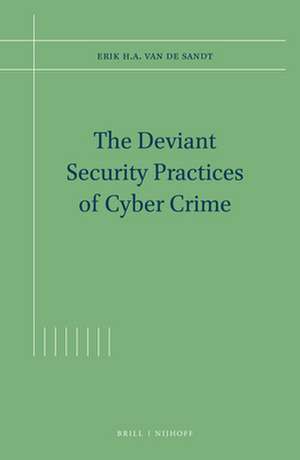The Deviant Security Practices of Cyber Crime
Autor Erik H.A. van de Sandten Limba Engleză Hardback – 11 aug 2021
Preț: 882.32 lei
Preț vechi: 1076.00 lei
-18% Nou
Puncte Express: 1323
Preț estimativ în valută:
168.85€ • 175.28$ • 140.79£
168.85€ • 175.28$ • 140.79£
Carte indisponibilă temporar
Doresc să fiu notificat când acest titlu va fi disponibil:
Se trimite...
Preluare comenzi: 021 569.72.76
Specificații
ISBN-13: 9789004463172
ISBN-10: 9004463178
Dimensiuni: 155 x 235 mm
Greutate: 0 kg
Editura: Brill
Colecția Brill | Nijhoff
ISBN-10: 9004463178
Dimensiuni: 155 x 235 mm
Greutate: 0 kg
Editura: Brill
Colecția Brill | Nijhoff
Cuprins
Foreword
List of Figures and Tables
Nomenclature
1 Introduction
1.1 Research Direction & Objectives
1.2 Who Should Read This Book & Why?
1.3 Methodological Approach
1.4 Novel Contributions
1.5 Outline of the Book
PART 1
Current Perspectives on Security
2 ‘Good Guy’ Perspectives on Security
2.1 Security as an Ongoing Process
2.2 Current Perspective on Technical Computer Security
2.3 Current Perspectives on Cyber Security & Cyber Crimes
2.3.1Why Cyber Crime is (not) Cyber Security
2.3.2Border-Centric View on Cyber Security & Cyber Crimes
2.3.3Borderless View on Cyber Security & Cyber Crimes
2.4 Interim Conclusion and Discussion
3 Touching upon Security Controls of Cyber Criminals
3.1 Computer Science & Engineering Literature
3.1.1Anti-Forensics
3.1.2Botnet Protection
3.1.3Authorship Analysis
3.1.4Attacker Economics
3.1.5Interim Conclusion & Discussion
3.2 Social Science Literature
3.3 Legal Studies
3.4 Interim Conclusion and Discussion
PART 2
Researching Cyber Crime and Deviant Security
4 A Multidisciplinary Approach for Deviant Security
4.1 Descriptive: Grounded Theory for Deviant Security Practices
4.1.1Cyber Criminal and Cyber Security Participants
4.1.2Secondary Data Sources
4.1.3Data Collection, Analysis and Writing
4.2 Explanatory: Information Age & Microeconomic Theory
4.2.1Deviant Security in the Information Age
4.2.2The Microeconomics of Deviant Security
4.3 Limitations
4.4 Ethical Issues
PART 3
A Theory on Deviant Security
5 What? – Basic Qualities of Deviant Security
5.1 Definition: What Makes Security Deviant?
5.2 Meaning: Subjective Condition
5.3 Provision: Club, Common, Private and Public Good
5.4 Function: An Asset To Protect Assets
5.5 Form: Intangible and Tangible Products & Services
5.6 Interim Conclusion and Discussion
6 Who? – Interactive Qualities of Deviant Security
6.1 Autarkic & Autonomous Referent Objects
6.2 DevSec Providers & Services
6.3 Threat Agents & Attacks
6.4 Information Asymmetries in Intertwined Networks
6.5 Deception as Deviant Security Control
6.6 Trust and Distrust as Deviant Security Controls
6.7 Interim Conclusion and Discussion
7 When & Where? – Temporal-Spatial Qualities of Deviant Security
7.1 Countermeasures Against Data Volatility & Retention
7.2 Intercultural Communication as a Countermeasure
7.3 Distribution as a Countermeasure
7.4 Physical Deviant Security
7.5 Interim Conclusion and Discussion
8 Investigative Responses Against Deviant Security
8.1 Security-Driven Investigations That Provide Human Security
8.2 Investigations as a Public Service With Multiple Outcomes
8.3 Technical Harmonization for a Global Investigation System
8.4 Reactive & Proactive Investigations on Commission & Protection
8.5 Data Scientific Investigations that Serve the Public Interest
8.6 Interim Conclusion & Discussion
PART 4
Conclusions
9 The Outlook of Deviant Security
9.1 Research Objectives Reiterated
9.2 A Filled-In Deviant Security Process Cycle
9.3 Summary of Findings
9.4 Moving Forward From Findings
9.5 Concluding Remarks
Bibliography
Index
List of Figures and Tables
Nomenclature
1 Introduction
1.1 Research Direction & Objectives
1.2 Who Should Read This Book & Why?
1.3 Methodological Approach
1.4 Novel Contributions
1.5 Outline of the Book
PART 1
Current Perspectives on Security
2 ‘Good Guy’ Perspectives on Security
2.1 Security as an Ongoing Process
2.2 Current Perspective on Technical Computer Security
2.3 Current Perspectives on Cyber Security & Cyber Crimes
2.3.1Why Cyber Crime is (not) Cyber Security
2.3.2Border-Centric View on Cyber Security & Cyber Crimes
2.3.3Borderless View on Cyber Security & Cyber Crimes
2.4 Interim Conclusion and Discussion
3 Touching upon Security Controls of Cyber Criminals
3.1 Computer Science & Engineering Literature
3.1.1Anti-Forensics
3.1.2Botnet Protection
3.1.3Authorship Analysis
3.1.4Attacker Economics
3.1.5Interim Conclusion & Discussion
3.2 Social Science Literature
3.3 Legal Studies
3.4 Interim Conclusion and Discussion
PART 2
Researching Cyber Crime and Deviant Security
4 A Multidisciplinary Approach for Deviant Security
4.1 Descriptive: Grounded Theory for Deviant Security Practices
4.1.1Cyber Criminal and Cyber Security Participants
4.1.2Secondary Data Sources
4.1.3Data Collection, Analysis and Writing
4.2 Explanatory: Information Age & Microeconomic Theory
4.2.1Deviant Security in the Information Age
4.2.2The Microeconomics of Deviant Security
4.3 Limitations
4.4 Ethical Issues
PART 3
A Theory on Deviant Security
5 What? – Basic Qualities of Deviant Security
5.1 Definition: What Makes Security Deviant?
5.2 Meaning: Subjective Condition
5.3 Provision: Club, Common, Private and Public Good
5.4 Function: An Asset To Protect Assets
5.5 Form: Intangible and Tangible Products & Services
5.6 Interim Conclusion and Discussion
6 Who? – Interactive Qualities of Deviant Security
6.1 Autarkic & Autonomous Referent Objects
6.2 DevSec Providers & Services
6.3 Threat Agents & Attacks
6.4 Information Asymmetries in Intertwined Networks
6.5 Deception as Deviant Security Control
6.6 Trust and Distrust as Deviant Security Controls
6.7 Interim Conclusion and Discussion
7 When & Where? – Temporal-Spatial Qualities of Deviant Security
7.1 Countermeasures Against Data Volatility & Retention
7.2 Intercultural Communication as a Countermeasure
7.3 Distribution as a Countermeasure
7.4 Physical Deviant Security
7.5 Interim Conclusion and Discussion
8 Investigative Responses Against Deviant Security
8.1 Security-Driven Investigations That Provide Human Security
8.2 Investigations as a Public Service With Multiple Outcomes
8.3 Technical Harmonization for a Global Investigation System
8.4 Reactive & Proactive Investigations on Commission & Protection
8.5 Data Scientific Investigations that Serve the Public Interest
8.6 Interim Conclusion & Discussion
PART 4
Conclusions
9 The Outlook of Deviant Security
9.1 Research Objectives Reiterated
9.2 A Filled-In Deviant Security Process Cycle
9.3 Summary of Findings
9.4 Moving Forward From Findings
9.5 Concluding Remarks
Bibliography
Index
Notă biografică
Erik H.A. van de Sandt, Ph.D. (2019), University of Bristol, is research fellow in cyber security at that university, practitioner-in-residence at the UK’s National REPHRAIN Centre and police officer in the National High Tech Crime Unit of the Dutch national police.
